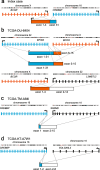Fusions involving BCOR and CREBBP are rare events in infiltrating glioma
- PMID: 32493417
- PMCID: PMC7271411
- DOI: 10.1186/s40478-020-00951-4
Fusions involving BCOR and CREBBP are rare events in infiltrating glioma
Abstract
BCOR has been recognized as a recurrently altered gene in a subset of pediatric tumors of the central nervous system (CNS). Here, we describe a novel BCOR-CREBBP fusion event in a case of pediatric infiltrating astrocytoma and further probe the frequency of related fusion events in CNS tumors. We analyzed biopsy samples taken from a 15-year-old male with an aggressive, unresectable and multifocal infiltrating astrocytoma. We performed RNA sequencing (RNA-seq) and targeted DNA sequencing. In the index case, the fused BCOR-CREBBP transcript comprises exons 1-4 of BCOR and exon 31 of CREBBP. The fused gene thus retains the Bcl6 interaction domain of BCOR while eliminating the domain that has been shown to interact with the polycomb group protein PCGF1. The fusion event was validated by FISH and reverse transcriptase PCR. An additional set of 177 pediatric and adult primary CNS tumors were assessed via FISH for BCOR break apart events, all of which were negative. An additional 509 adult lower grade infiltrating gliomas from the publicly available TCGA dataset were screened for BCOR or CREBBP fusions. In this set, one case was found to harbor a CREBBP-GOLGA6L2 fusion and one case a CREBBP-SRRM2 fusion. In a third patient, both BCOR-L3MBTL2 and EP300-BCOR fusions were seen. Of particular interest to this study, EP300 is a paralog of CREBBP and the breakpoint seen involves a similar region of the gene to that of the index case; however, the resultant transcript is predicted to be completely distinct. While this gene fusion may play an oncogenic role through the loss of tumor suppressor functions of BCOR and CREBBP, further screening over larger cohorts and functional validation is needed to determine the degree to which this or similar fusions are recurrent and to elucidate their oncogenic potential.
Keywords: BCOR; CREBBP; Fusion; Infiltrating glioma.
Conflict of interest statement
The authors declare that they have no competing interests.
Figures




References
-
- Agerstam H, Lilljebjörn H, Lassen C, Swedin A, Richter J, Vandenberghe P, et al. Fusion gene-mediated truncation of RUNX1 as a potential mechanism underlying disease progression in the 8p11 myeloproliferative syndrome. Genes Chromosomes Cancer. 2007;46:635–643. doi: 10.1002/gcc.20442. - DOI - PubMed
-
- Brat DJ, Aldape K, Colman H, Holland EC, Louis DN, Jenkins RB, et al. cIMPACT-NOW update 3: recommended diagnostic criteria for "diffuse astrocytic glioma, IDH-wildtype, with molecular features of glioblastoma, WHO grade IV". Acta Neuropathol. 2018;136:805–810. doi: 10.1007/s00401-018-1913-0. - DOI - PMC - PubMed
Publication types
MeSH terms
Substances
LinkOut - more resources
Full Text Sources
Other Literature Sources
Medical
Miscellaneous

